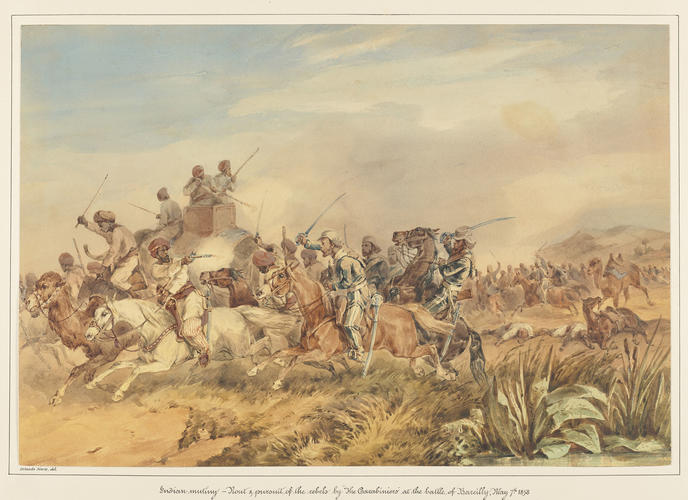-
1 of 253523 objects
The Indian Rebellion: 6th Dragoon Guards (Carabiniers) at Bareilly, May 1858 signed and dated May 1858
Watercolour | 31.8 x 46.8 cm (whole object) | RCIN 990619

Orlando Norie (1832-1901)
Indian Mutiny: 6th Dragoon Guards (Carabiniers) at Bareilly, May 1858 signed and dated May 1858
-
A watercolour showing the 6th Dragoon Guards, in action against Indian cavalry at Bareilly, May 1858. Signed. Inscribed, verso: The Rout & Pursuit of the Rebels by 'The Carabiniers' at the Battle of Bareilly (altered from Kuknow[li]), 7 May 1858.
During the Indian Rebellion, Bareilly in northern India (in the present day state of Uttar Pradesh) was the site of fierce rebel resistance, led by Khan Bahadur Khan, against British East India Company regiments. On 5 May 1858 Sir Colin Campbell's forces, which included Punjabi infantrymen, joined battle with Khan's army which had come out of the city to engage the enemy. After fierce fighting Khan's men retreated and the British forces took the city. The battle was witnessed by William Simpson, the Times correspondent, who described the mayhem caused by the confrontation in his diary:
'It was a veritable stampedo of men and animals. Elephants were trumpeting shrilly as they thundered over the fields, camels slung along at the utmost of their jogging stride, horse and tats (ponies), women, and children were all pouring in a stream, which converged and tossed in heaps of white and black as it neared the road- an awful panic!'
The Indian Rebellion, or the First War of Independence (commonly known as the Indian Mutiny) was sparked in May 1857 by an incident among angered Indian soldiers serving the British East India Company stationed at Meerut. It was swiflty joined by Bengal Infantry regiments and civilians, spreading across north and north east India to include the cities of Delhi, Agra, Kanpur and Lucknow. Simmering resentment at colonial rule formed the backdrop to the Rebellion. The British East India Company's annexation of lands, crippling taxation and religious intolerance were among the many causes.
Orlando Norie was born into a well-known Scottish artistic family but spent much of his working life in France. He is particularly known as a painter of military scenes, and had a long-lasting professional relationship with the printsellers and publishers Ackermann & Co who managed his picture sales and published lithographs after his drawings, beginning with scenes of the Crimean War in the 1850s. He is not thought to have travelled outside of Europe, and therefore his depictions of colonial military action are not personal eye-witness accounts. The significant group (c.70) of watercolours by Norie now in the Royal Collection primarily came from two sources - Queen Victoria, via purchase or commission, and at least eighteen which were previously in the collection of her son Prince Arthur, Duke of Connaught, who served in the British Army. These were given to the Royal Collection after his death in 1942.Provenance
RCINs 990618, 990619, 990620 may be the watercolours acquired by Queen Victoria on 6 December, 1858, for £7.17s. 6d.
-
Creator(s)
Acquirer(s)
-
Medium and techniques
Watercolour
Measurements
31.8 x 46.8 cm (whole object)
Other number(s)
RL O : Royal Library "O" Number Register – RL O0619